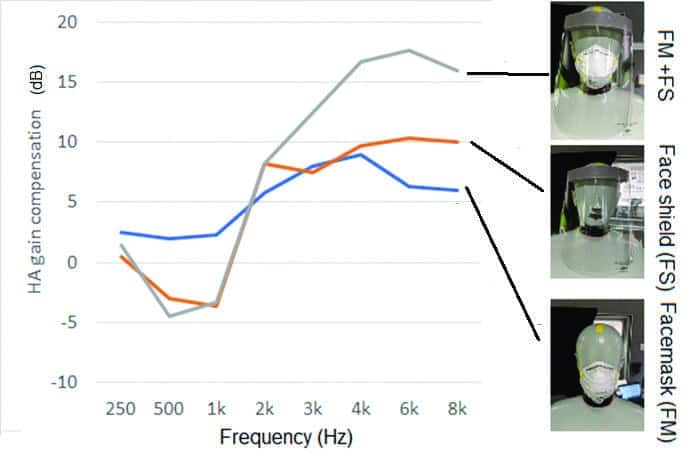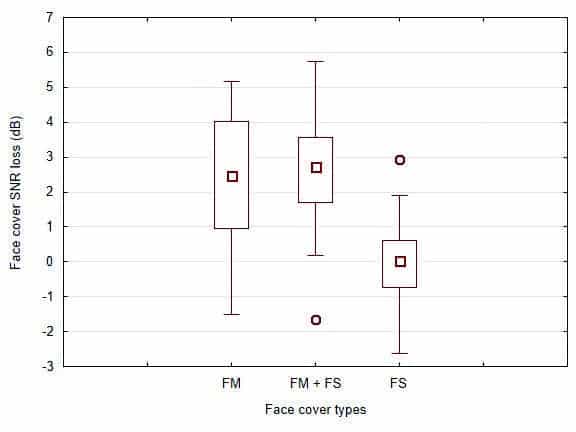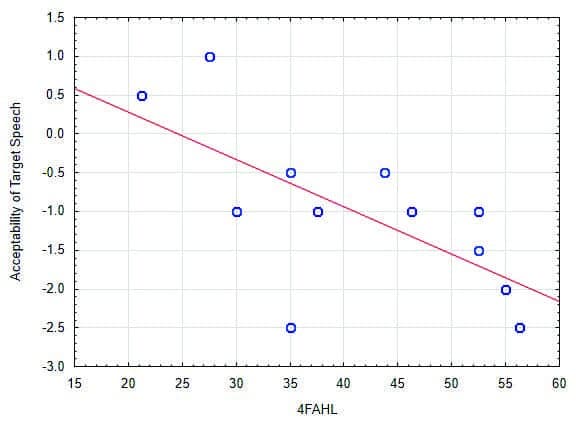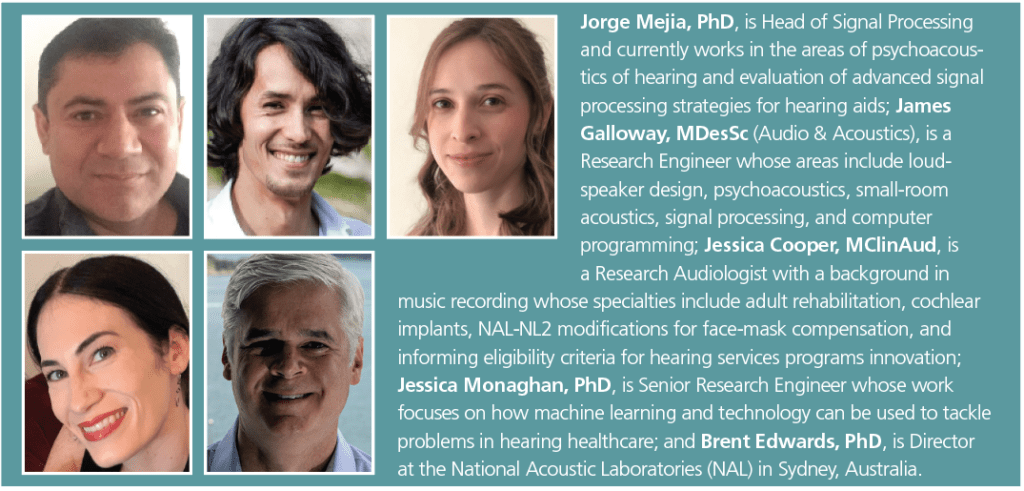Research | August 2021 Hearing Review
The effects of face masks, face shields, and both when listening to speech in noise
By Jorge Mejia, PhD; James Galloway, MDesSc; Jessica Cooper, MClinAud; Jessica Monaghan, PhD, & Brent Edwards, PhD
Face covers such as face masks and face shields have been successfully used as preventative measures against the spread of COVID-19. The use of face masks has been mandated by many governments around the world. A negative side effect has been the impact on speech understanding in noise. In this study, we focus on examining the impact of face covers in laboratory experiments and evaluate the effect of hearing aid compensation to reduce the impact of face covers during speech communication. Methods, outcomes, and recommendations are presented.
Hearing in noise is particularly challenging for hearing-impaired listeners. The COVID-19 pandemic has prompted the use of face covers as effective deterrents of the virus.1 However, this has also impacted the quality of speech understanding. Face covers function as low pass filters, reducing the energy of speech at high frequencies.2 At least one study has demonstrated that the effect of face covers is substantial enough to reduce speech intelligibly in noise for normal-hearing listeners.3
Despite of the known impact of face covers on speech understanding in noise, there is limited evidence to demonstrate the effect of on hearing-impaired listeners.4 Previously studies have suggested that have limited impact in quiet listening situations.5 However, anecdotal evidence from clinics indicated that hearing-impaired listeners are particularly impacted by common use of face covers, particularly face masks and the combination of face mask and face shields.
In this paper we present evidence of the impact of face covers with a group of listeners with hearing impairment. In addition, we evaluate the impact of compensating for the effect of face covers using hearing aid amplification. We also examine the impact in relation to speech understanding in noise and acceptability of loudness, naturalness and overall quality of other sounds, own-voice, and to the target speech.
Research Methods
A total of 12 participants with mild-to-moderate hearing loss attended a 2½ hour appointment in the laboratory. The participants were fitted with a set of commercially available hearing aids (HA), targeting NAL-NL2 amplification settings. A conventional fitting was copied into 3 other stored programs. The gains for the additional programs were further adjusted to compensation for the effect of three face cover types: face mask (FM), face shield (FS), and a combination of the two (FM+FS). The adjustment was verified with real-ear measurements (REM), and on average less than 5 dB deviation was observed between targeted and measured output levels.
Figure 1 shows the acoustic setup which comprised a loudspeaker array, with a radius of 1.6 m. Figure 1 shows the 16 receivers covering the full circle with the head-and-torso simulator (HATS) mouthpiece, which was used as the speech source, positioned in front of the participant seated at the center of the array. The baseline measure was taken with no face cover on the HATS. For the 6 other measures, face covers were placed on HATS: 3 conditions where no compensation was provided, and 3 conditions where compensation for the face cover effects was provided.

Figure 2 shows HA gain adjustment necessary to compensation for the full effect of the 3 different types of face covers relative the baseline (ie, HATS with no face cover). The behavioral measures included:
- Speech-in-noise test: Recall of Australian English sentences (BEST test6) presented by HATS in 8-talker speech babble, with diffuse noise presented by the surrounding speaker array. The level of the target was set to 65 dB SPL while the background noise was adjusted until 75% speech recall performance was reached.
- Acceptability ratings: Listening task to a speech monolog presented by HATS in a simulated realistic cafeteria, coded using Ambisonic reproduction methods. Participants were asked to rate the acceptability of the loudness of the background noise, their own-voice, and of the target speech.

RESULTS
1) Speech-in-Noise Test
Figure 3 shows the effect of the three types of face covers, with no compensation, on the SNR required to achieve 75% speech understanding relative to the baseline. Friedman’s ANOVA test revealed a significant effect of face-cover type (χ2(3) = 18.100, p < 0.001). A posthoc Wilcoxon signed-rank test indicated that there was a significant median degradation of 2.5 dB SNR with face mask (FM, p = 0.012) and a significant median degradation of 2.783 with a combination of face mask and face shield (FM+FS, p = 0.005), but no effect of face shield alone (FS, p = 0.480).

Figure 4 shows the effect of the three types of face covers, with HA compensation, on the SNR required to achieve 75% speech understanding, relative to the no compensation conditions. In terms of the effect of compensation, Friedman’s ANOVA test revealed a significant effect of face cover type (χ2(2) = 6.500, p = 0.038). A posthoc Wilcoxon signed-rank test indicates that in the facemask condition there was a median improvement of 0.74 dB SNR with compensation (FM, p =0. 050). A median degradation of 1.39 dB SNR with compensation in the face shield condition reached near significance (FS, p = 0.071), but compensation had no significant effect in combination of face mask and face shield condition (FM+ FS, p = 0.480).

2) Loudness Acceptability Scores
The Friedman ANOVA was applied to scores for the acceptability of other sounds and revealed no significant detriment of compensation (χ2(3) = 5.800, p = 0.122). However, on average, the scores were slightly lower for the compensated condition relative to the baseline. Similarly, we observed no significant effect on the acceptability of own voice with compensation compared to the baseline (χ2(3) = 4.104, p = 0.251). Finally, compensation had a significant effect on the acceptability of the target speech (χ2(3) = 9.356, p = 0.025). The posthoc test revealed that participants preferred the compensated FM and FM+FS condition by 1 point in the scale (p < 0.02).
3) Candidacy for Compensation
Figure 5 shows acceptability scores, relative to the baseline, for speech in the face mask condition with no compensation, as a function of 4-frequency average hearing loss (4-FAHL). The fitted regression line explains 45% of the variance (r = -0.670, p = 0.012). The slope of the line predicts a reduction of 1 point for every 16 dB HL loss, with an intercept at 25 dB HL.

Summary
These results indicate that face masks have a degrading effect on speech understanding in noise equivalent to an average reduction in SNR of 2.5 dB. However, face shields had no effect, with listeners having comparable performance to the baseline condition.
Adjusting the hearing aid gain to fully compensate for the effect of the face mask has a positive effect on speech understanding in noise. However, this effect was not observed when a face shield was in used, nor in with combined face mask and shield condition. A likely reason for this is that compensation also increases the background noise, and in the case with a face shield, the increase in background noise level outweighs the improvement in audibility of target speech.
Subjective ratings of speech with face covers in realistic listening conditions were comparable to the speech-in-noise outcomes. For some participants there was a degradation in the acceptability of other sounds, but the group effect was not significant, nor was there a significant effect on own-voice acceptability scores. On the other hand, compensation improved the acceptability of the target speech in both face mask (FM) and combination face mask with face shield conditions (FM+FS). Thus, in the face mask condition, listeners attained a perceptual benefit from compensation, evident in the intelligibly and subjective ratings while listening in noise.
Finally, the reduction in acceptability of speech with a face mask (without compensation) relative to the baseline was correlated to the hearing loss. This suggests that hearing-impaired participants are the most likely candidates to benefit from compensation for the effect of face masks using gain adjustments to their hearing aid settings.
Recommendations
The evidence thus far shows that HA-gain compensation for face masks is beneficial to hearing-impaired listeners. However, in clinical practice, the gain required for full compensation may also require occluded ear fittings, which is not acceptable for many listeners.

Table 1 shows moderate levels of gain adjustment needed to compensate for the effect of a face mask in everyday speech communications. These gains were derived by averaging several types of facemasks. It is recommended that the clinicians use the table with caution in order to avoid sound quality degradation and feedback. In addition, the recommendation will be more effective with the highest directional features available, and the noise reduction setting turn on, to reduce the potential adverse effect that compensation has on other sounds. Finally, facemask options should be made available to hearing aid users who are able to manage the different program options in their devices, or to those who are able to receive supervised care with their hearing aid usage.
Correspondence can be addressed to Dr Mejia at: [email protected].
Citation for this article: Mejia J, Galloway J, Cooper J, Monagham J, Edwards B. Managing the impact of face masks and covers on speech understanding in noise using hearing aids. Hearing Review. 2021;28(8):26-28.

References
- World Health Organization (WHO) website. Coronavirus disease (COVID-19): Masks. https://www.who.int/news-room/q-a-detail/coronavirus-disease-covid-19-masks. Published December 1, 2020.
- Goldin A, Weinstein B, Shiman N. How do medical masks degrade speech reception? Hearing Review. 2020;27(5):8-9.
- Wittum KJ. The Effects of Surgical Masks on Speech Perception in Noise. Research thesis. The Ohio State University; April 2013. https://kb.osu.edu/bitstream/handle/1811/54759/1/Thesis_to_Upload.pdf.
- Martin L. NAL update: Impact of face masks and face shields on communication. Hearing Review. 2020;27(10):28-29.
- Mendel LL, Gardino JA, Atcherson SR. Speech understanding using surgical masks: A problem in health care? J Am Acad Audiol. 2008:19(9):686-695.





